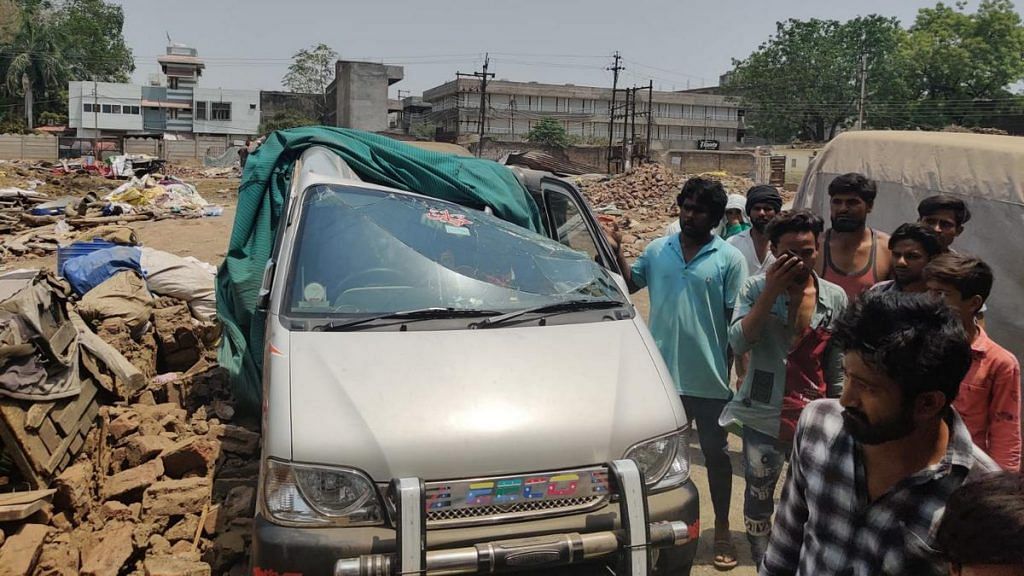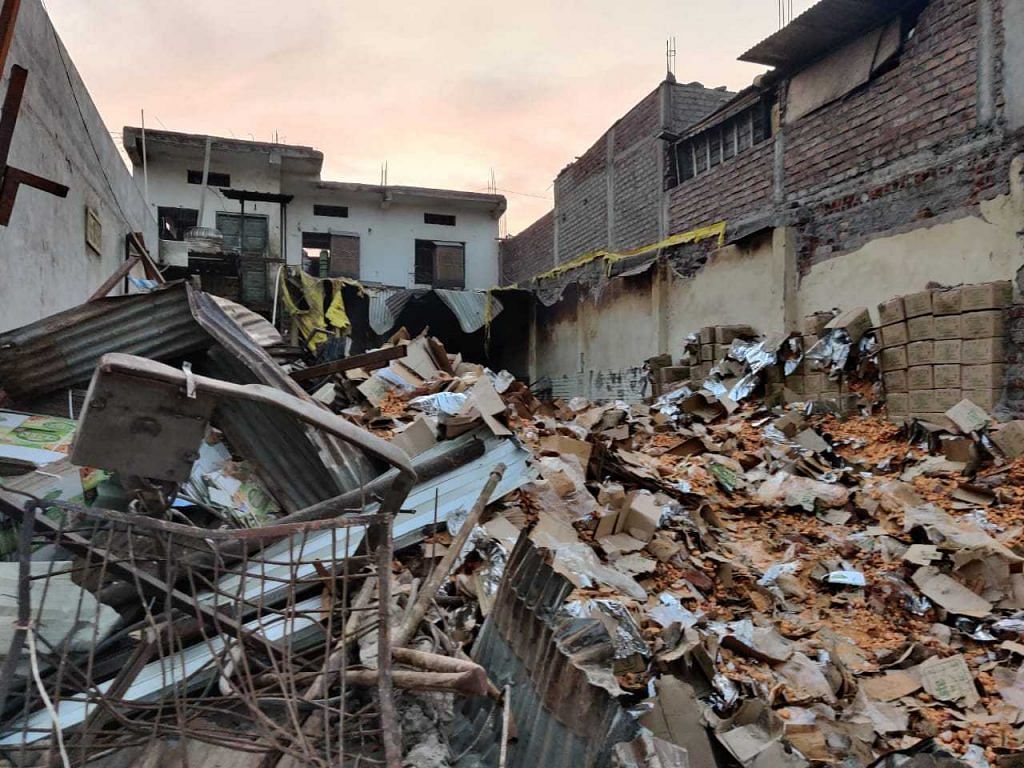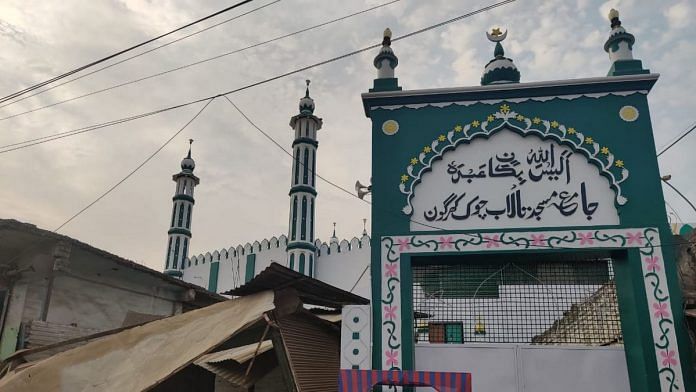Khargone: Following the communal violence on Ram Navami last Sunday, which involved incidents of stone-pelting and arson, the district administration of Khargone in Madhya Pradesh has gone on a demolition drive targeting “illegally built” houses in areas where rioting took place to “send rioters a message”.
Speaking to ThePrint, district collector P. Anugraha said that much of the rioting took place within a 5-km radius. “We identified the areas where maximum rioting had taken place. We then selected those areas where there were encroachments — illegal structures — on government land. We then conducted a drive to send a message to the rioters and the people who were affected,” she said.
When asked how the administration was able to start targeting the “illegal” houses a day after the clash, without any of the alleged rioters being convicted in a court, the district collector said: “The chargesheet will tell everything.”
Anugraha added that the administration had not demolished the houses of “everyone” who had been arrested. “We aren’t here to trouble innocent people,” she said.
Officials in the district administration say that those whose houses and businesses were razed were given prior notice, but many of the affected told ThePrint that this was not the case and they were taken by surprise when bulldozers and police personnel arrived at their doors.
According to legal experts, even if notices were served to those on the encroached land, they should have been given a fair chance to appeal against the demolition.
“This is not the way of punishing anyone. This a crime against society — prosecuting people for another alleged crime under encroachment laws,” Ehtesham Hashmi, a lawyer in the Supreme Court, said.
On Thursday, MP Chief Minister Shivraj Singh said in a speech, which he later tweeted: “Those whose houses were burnt (in the riot), we will get their houses rebuilt. As for those who burnt the houses, we will make them pay in full. I will not leave them.”
आप सारे त्यौहार धूमधाम उत्साह के साथ भाईचारे के साथ मनाया हनुमान जयंती, गुड फ्राइडे, ईद सभी प्रेम के साथ मनाएं।
सरकार सबके साथ है।
जिनके घर जले हैं, हम उनके घर फिर से बनवाएंगे और जिन्होंने घर जलाए हैं उनसे ही वसूली की जाएगी। उनको छोडूंगा नहीं। #AmbedkarJayanti pic.twitter.com/SPRPoxfKFM
— Shivraj Singh Chouhan (@ChouhanShivraj) April 14, 2022
State Home Minister Narottam Mishra, soon after the clashes, said, “Jis ghar se patthar aaye hain, us ghar ko hi pattharon kaa dher banayenge (The houses from where stones were pelted will be turned into rubble.”
Whether or not “stones were pelted” from them, many houses have indeed turned to rubble in Khargone.
Also Read: ‘Stone-pelters will be greeted with bulldozer’: BJP defends MP govt action on Khargone riot
How shops, eateries, homes were razed
A day after some people pelted stones at a Ram Navami procession organised by a gau raksha (cow protection) outfit, resulting in communal clashes, Khargone authorities started demolishing buildings in the affected areas — starting with the Chhote Mohan Talkies locality, followed by Aurangpura, Khaskhaswadi, Ganesh Mandir, and Talab chowk.

Sheikh Mohammed Rafique, who lives in the Chhote Mohan Talkies neighbourhood, claimed that three buildings belonging to his family were destroyed, and that he had not received any recent notice.
“We didn’t get any time to empty the shops. My house is right behind them, where 14 of us live together, including nine children. We were sleeping after sehri (pre-dawn meal consumed during Ramadan) when the police and authorities came to our house with JCBs (bulldozers),” Rafique said, adding that his father had tried to speak to the officials present but to no avail.
Rafique is convinced that the Muslim community is being targeted in the demolition drive. “The authorities came under pressure to prove to the majority that they will take action,” he said.
He added that a tehsildar had visited them about nine or 10 months ago about demolitions but at that time only five or six other nearby houses had been razed. “They had made a panchnama putting our shops also in the encroachment area. We had submitted an application also to the authorities but received no reply,” he said.
In this area, two eateries facing each other, known as the Waqt Hotels, were also destroyed.
Kashish, whose father Rasheed owns one of the restaurant buildings, said that they had received a notice five to six years ago. “The notice had said that if in the future the road is widened then parts of our hotel will be broken,” she said. Atiq, who owns the smaller of the two eateries, said he was never given a notice and plans to approach the courts.
In the Jama Masjid complex at Talab Chowk, the authorities razed 12 shops.
According to P. Anugraha, the area is allocated for a drain construction, and other officials have also reportedly claimed to have posted notices here six months ago. However, many shopkeepers allege they were not given any intimation, although some mentioned that officials had come to take measurements in the area some months ago..
One of the buildings that has been razed to the ground is Super Bakery, about 400 metres from Talab Chowk.
“I have been running this bakery for 15 years and have incurred a loss of Rs 20 lakh. We didn’t riot, then why are we suffering?” owner Amjad Khan said.

In the Khaskhaswadi area, which is located near Bhaswar mohalla where heavy stone-pelting had reportedly taken place, several small brick houses and a few shops were demolished.
Four families here said they had received notices on 7 April to empty their houses within three days. One of these homes had been built under the Pradhan Mantri Awas Yojana (PMAY), a government subsidised housing scheme. The owner, Amjad, said, because of the weekend, he was not able to submit the necessary property documents on time to the tehsildar.
When asked about this, the district collector said that the construction of the house had been approved for another plot, and not on government land. Amjad denied this and said he had necessary approvals.
Rasheeda, who lives with her daughter and granddaughter in Khaskhaswadi was distraught when ThePrint met her. Both her home and small shop had been reduced to rubble. “I lost everything. I had brought some items for Ramzan… everything is gone,” she said.
“They did give us notices some eight months ago, but didn’t do anything. Now, they have taken advantage of the riot and targeted us. We are living in tents,” another resident, Abid Khan, said.
Data accessed by ThePrint from state authorities showed that 45 “illegal” structures were demolished in this week’s drive.
These included 12 houses and 10 shops in Khaskhaswadi, four houses and three shops in Chhote Mohan Talkies, one shop near Ganesh Mandir, three shops in Aurangpura, and 12 shops in the Talab Chowk area Monday. In addition, at least two eateries and one bakery were targeted Tuesday. No demolitions took place Wednesday.
District collector P. Anugraha, however, said these figures were “wrong” since some of the homes and shops were temporary “tin” structures built by people who had other places to live in.
According to her, only 16 to 20 shops and four houses were razed and “that too only tin structures”.
Experts question legality of demolitions
The district collector told ThePrint that the demolitions in Khargone were carried out under the provisions of the Madhya Pradesh Municipal Corporation Rules as well as the MP Land Revenue Code.
However, several legal experts said there appeared to be several problematic aspects to the way the exercise was carried out.
According to Ankit Premchandani, an Indore-based lawyer, the authorities are duty-bound to give appropriate notices and follow certain procedures before embarking on demolitions.
“A series of permissions have to be taken before a building is razed. The principles of natural justice say that the party has to be given time to appeal and an opportunity of hearing, to state why their house should not be demolished,” he said, adding that it is also acceptable to serve a notice by pasting it on a door if no one is available to receive it.
“It is pasted and a photo is clicked by the authorities and it is deemed to have been served,” he said.
Abhinav B. Dhanodkar, another MP-based lawyer, also pointed out that under the state municipal corporation law, at least three days’ time should be given to people to vacate properties on encroached land.
“There are multiple orders by the Supreme Court and the high court that reasonable time should be given. A notice should mention the reason on why the house is illegal — whether the map is not sanctioned or the house is dilapidated and dangerous, or an encroachment,” Dhanodkar said.
Further, in 2016, the Madhya Pradesh Municipal Corporation Rules allowed for the legalisation of unauthorised constructions in buildings by paying a fee.
“The compounding fee needs to be deposited within a certain amount of time for that particular illegal construction. This opportunity must be given to all parties,” Premchandani said.
Delhi-based lawyer Anas Tanwir also drew attention to due process. “There has to be adjudication — by the executive magistrate or the civil court. Before demolition also, they have to serve a notice that they are coming on so-and-so date to demolish their house and provide them reasonable time,” he said.
Speaking to ThePrint, Supreme Court advocate Ehtesham Hashmi said the legal ramifications of the MP government’s demolition campaign extended beyond whether a notice was given.
He called the drive a violation of Article 21, which pertains to protection of life and liberty, because people were punished for “another alleged crime” under encroachment laws without being given their right to a fair trial and legal aid.
“This has no legal validity,” Hashmi said. “Even if they have been given notices, you cannot do it in this way… In a curfew zone, they have singled out areas, and, one fine day, demolished their houses.”
Past instances of demolition as ‘punishment’
There are multiple instances of the Madhya Pradesh government demolishing “illegal structures” immediately following other allegations against the “encroachers” in question.
In December 2020, authorities in Ujjain demolished a house belonging to one Abdul Rafeeq after a stone-pelting incident during a Bharatiya Janata Yuva Morcha rally.
In this instance too, the district collector had claimed that the demolition achieved two goals: targeting illegal encroachment as well as “criminals who resort to such acts of stone-pelting”.
Former Supreme Court judge Justice Deepak Gupta had described this incident as “absolutely illegal and an act of a police state”. He had also said that incidents like this pointed towards the police and politicians taking the law into their own hands and demonstrating their lack of faith in the courts.
Last year, too, a Muslim man’s house was razed in Dhar after a stone-pelting incident at a rally carried out by Hindutva groups. At that time, the superintendent of police had told mediapersons that the house was illegal, but the subdivisional magistrate had averred that it was a “warning to anti-social elements who disrupt the peace”.
(Edited by Asavari Singh)
Also Read: ‘UP mein Baba, MP mein Mama’ — Shivraj Chouhan unveils Yogi-style model of governance



